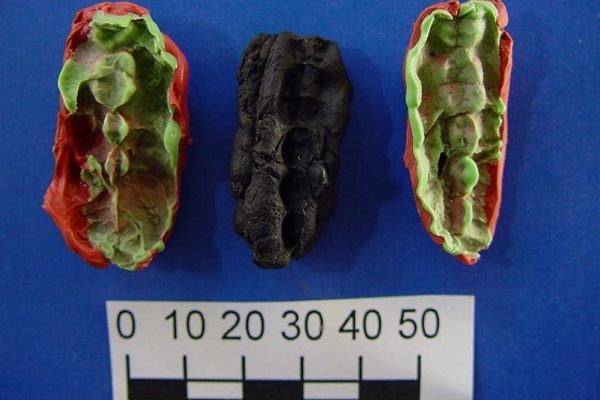Super Fun Superfund: Canoeing on the Gowanus Canal
The Gowanus Canal (all photographs by the author unless indicated)
Having grown up in Brooklyn just a few blocks away, the stench of Gowanus water reminds me of my childhood, but for all the time I’ve spent smelling the canal I never imagined I’d one day go canoeing on it — and then, this October, I did.
The Gowanus Dredgers Canoe Club is a volunteer organization that believes people should enjoy their waterfront, no matter how much lead, mercury, pesticide, cholera, typhoid, typhus, gonorrhea, and something called black mayonnaise (a 10-foot thick layer of various pollutants which cakes the bottom of the canal) it may be filled with. Logging over 2,000 trips last season, they have free outings weekly, the only requirement being that you wear a life vest. When I asked veteran dredger Owen Foote if he’d ever accidentally come in contact with canal water, he responded: “Certainly, and I have superpowers because of it.”
Indeed, both on and below its surface the Gowanus is filled with many a poison. Liquid coal tar, usually measured in parts per million, is measured in parts per hundred in the canal, and microbes found in the water have evolved a resistance to filth. Canoeing on the canal means pushing away plastic bags and empty soda cans with your oar, the vessel gliding over rainbow-colored clumps of chemicals and woefully soggy take out containers. At one point, I even passed a bubbling whirlpool of gunk, casually glugging away under one of the canal’s seven bridges.
1851 oil painting “Sunset at Gowanus Bay” by Henry Gritten (via Allport Library and Museum of Fine Arts, Tasmania)
Everybody’s favorite brownfield, today the Gowanus is practically venerated, a source of backwards Brooklyn pride as one of the most polluted spots in the nation — but it used to be much, much worse. Built in the mid-19th century in place of the Gowanus Creek, it quickly became a favorite dumping spot for local ink factories and the Mafia. In the 1880s, the canal was given its nickname “Lavender Lake” after its changing daily pigment due to the nearby dye manufacturers’ waste. At the time, some poor people were convinced that the rising rank fumes had healing powers, and would stand their asthmatic children on the canal bridges to absorb them. A common pastime in the warmer months was to stand on the banks and watch decomposing sludge boil and spit bubbles - some the size of basketballs - riding the surface.
By 1910, locals described the water as “almost solid with sewage.” A 6,200 foot underground tunnel was built in 1911 to flush the canal with fresh seawater, but even this small measure of health broke in 1961 when a city worker dropped a manhole cover on it. It wasn’t fixed until 1999. To date, the canal was last dredged in 1975, when it was found that nearly 20 feet of sediment had piled up on the shoreline.
A freshly designated Superfund site, the cost of cleanup for the Gowanus is estimated at $500 million. Although slime does not spit from the surface as it did two centuries ago, sewage still spills directly into the canal after storms, human waste changing the water’s normal dark grey color to an algae green. Recently, when oysters were left in the canal as an experiment to see if they would spawn, they not only died within two weeks, but their shells were partially eaten away by acidic compounds in the water. Filled with heavy metals like arsenic at 60 times healthy exposure levels, even the EPA admits they aren’t entirely sure what’s growing in the water.
Despite the filth, things that aren’t STDs occasionally find their way into the canal, to the delight of the Dredgers. In 2011, a muskrat was spotted near the canoe launch site, and the Dredgers immediately hailed it as the canal’s unofficial “Superfund mascot.” Living on mussels and attempting to build a nest with weed remnants from a house boat garden, the valiant animal was named GoGo Gowanus and has since moved to what can only be assumed to be cleaner waters.
In 2007, a tiny jellyfish was seen swimming southward from the Third Street Bridge, and in 2003 Gowanda, a one-year-old harp seal, was rescued by the Riverhead Foundation, hurt and bloodied, but now fully recovered. Other creatures of the Gowanus have not been so lucky. Also in 2007, a 12-foot minke whale named Sludgie swam into the canal, beached itself, and died. In 1950, a shark lost in the Gowanus served as target practice for the NYPD while hundreds watched from the banks. And just last year, a dolphin died under the Union Street Bridge after struggling for hours. The Dredgers talk excitedly about some of the species that have, very recently, begun returning to the waters, but it is a far cry from the foot-long oysters Dutch travelers reported in the 1600s.
The canal’s future is as foggy as the water, even with a recent EPA grant to assist cleanup, but activists hope to dredge the muck, lay a foot of clay over the bottom to seal in the bad stuff, and turn the banks into a wetland-like space called Gowanus Canal Sponge Park. For now, though, Brooklyn’s “Little Venice” remains a colorful cesspool of smut, and there is a peaceful solidarity canoeing along a body of water many won’t touch without a Hazmat suit.
Check out the Gowanus Dredgers Canoe Club to learn more about boating down this Brooklyn waterway.











Follow us on Twitter to get the latest on the world's hidden wonders.
Like us on Facebook to get the latest on the world's hidden wonders.
Follow us on Twitter Like us on Facebook